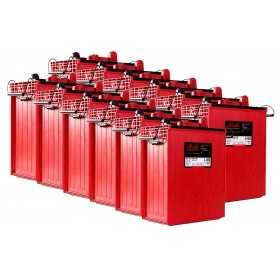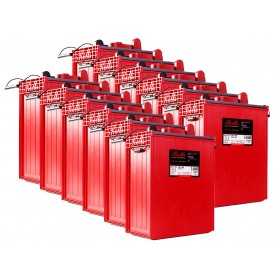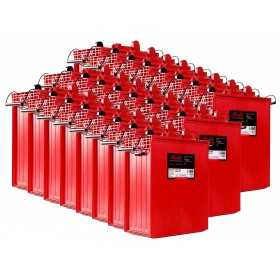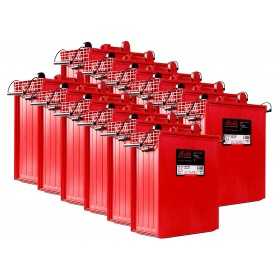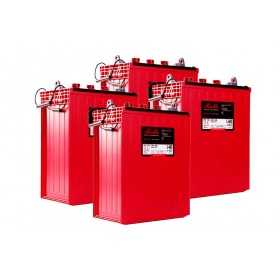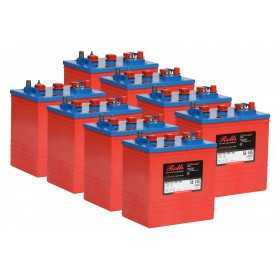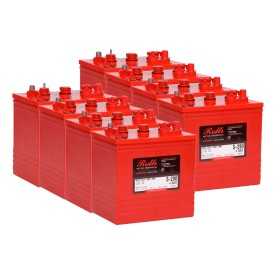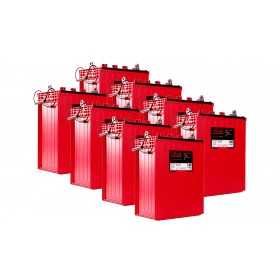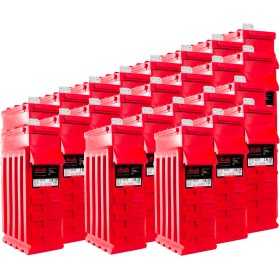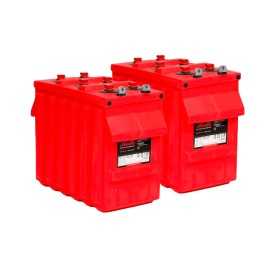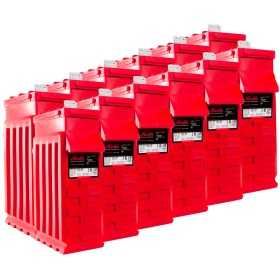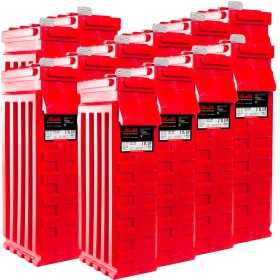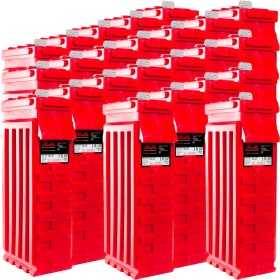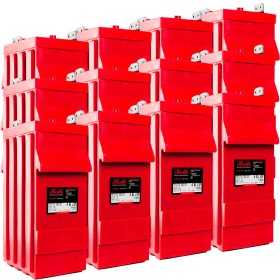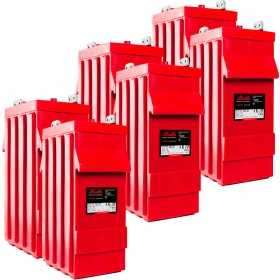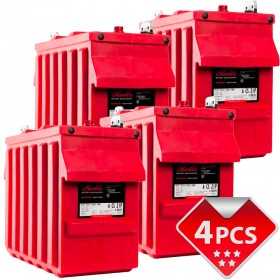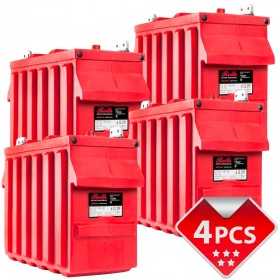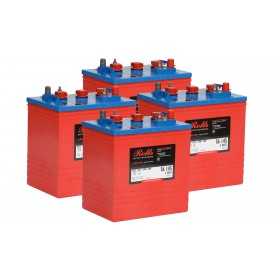Lead Acid Batteries
There are 36 products.
Rolls S1450 4000 Series Battery Bank 48 Volt 69.69 kWhC100 200ROLLSS1450-48V
Rolls S1450 4000 Series Flooded Deep Cycle Battery Bank (has 24 by 2V 1452Ah C100 Rolls Batteries)
€10,413.85
€17,356.42
Rolls S1450 4000 Series Battery Bank 24 Volt 34.84 kWh C100 200ROLLSS1450-24V
Rolls S1450 4000 Series Flooded Deep Cycle Battery Bank (has 12 by 2V 1452Ah C100 Rolls Batteries)
€5,640.84
€8,678.21
Rolls S1660 4000 Series Battery Bank 48 Volt 79.68 kWhC100 200ROLLSS1660-48V
Rolls S1660 4000 Series Flooded Deep Cycle Battery Bank (has 24 by 2V 1660Ah C100 Rolls Batteries)
€12,417.61
€20,696.02
Rolls S1660 4000 Series Battery Bank 24 Volt 39.84 kWhC100 200ROLLSS1660-24V
Rolls S1660 4000 Series Flooded Deep Cycle Battery Bank (has 12 by 2V 1660Ah C100 Rolls Batteries)
€6,726.21
€10,348.01
Rolls S1860 4000 Series Battery Bank 48 Volt 80.78 kWhC100 200ROLLSS1860-48V
Rolls S1860 4000 Series Flooded Deep Cycle Battery Bank (has 24 by 2V 1683Ah C100 Rolls Batteries)
€14,156.84
€23,594.74
Rolls S1860 4000 Series Battery Bank 24 Volt 44.85 kWhC100 200ROLLSS1860-24V
Rolls S1860 4000 Series Flooded Deep Cycle Battery Bank (has 12 by 6V 1869Ah C100 Rolls Batteries)
€7,078.42
€11,797.37
Rolls S480 4000 Series Battery Bank 24 Volt 10.77 kWhC100 200ROLLSS480-24V
Rolls S605 4000 Series Flooded Deep Cycle Battery Bank (has 4 by 6V 449Ah C100 Rolls Batteries)
€1,879.79
€2,685.41
Rolls S320 4000 Series Battery Bank 48 Volt 15.36 kWhC100 200ROLLSS320-48V
Rolls S320 4000 Series Flooded Deep Cycle Battery Bank (has 8 by 6V 320Ah C100 Rolls Batteries)
€2,551.23
€3,924.98
Rolls S290 4000 Series Battery Bank 48 Volt 14.12 kWh C100 200ROLLSS290-48V
Rolls S290 4000 Series Flooded Deep Cycle Battery Bank (has 8 by 6V 294Ah C100 Rolls Batteries)
€2,326.21
€3,578.78
Rolls S480 4000 Series Battery Bank 48 Volt 21.55 kWhC100 200ROLLSS480-48V
Rolls S480 4000 Series Flooded Deep Cycle Battery Bank (has 8 by 6V 449Ah C100 Rolls Batteries)
€3,491.03
€5,370.82
Rolls Battery Bank - 48V 24.19 kWh 200ROLLSS500EX
Rolls Battery Bank - 48V 24.19 kWh (Composed of 8 batteries Rolls of 6V 504Ah C100).
€4,688.91
€7,213.71
Rolls 12CS11P Battery Bank 24,14 kWh C100 200ROLLS12CS11P
Rolls 12CS11P Battery Bank - 48V 24,14kWh (Composed of 4 Rolls batteries of 12V 503Ah C100)
€5,703.58
€8,774.74
Rolls SERIES 4500 Battery Bank - 24V 12.10 kWh 200ROLLSS500EX-24
Rolls Battery Bank series 4500 - 24V 12.10 kWh (Composed of 4 Rolls batteries of 6V 504Ah C100).
€2,344.46
€3,606.86
5000 Rolls SERIES 48V 119.52kWh Rolls Battery Bank 200ROLLS2KS33P
5000 Rolls SERIES 48V 119.52kWh Rolls Battery Bank. Ideal for Off Grid photovoltaic systems. Composed of 24 Rolls 2 KS 33P 2V 2490Ah C100 lead acid batteries.
€22,189.62
€36,982.70
Rolls 12CS11P SERIES 5000 Battery Bank 24 VOLT 12,07 KWh C100 200ROLLS12CS11P-24V
ROLLS batteries series 5000 - 24 volt 503 Ah C100 (2 items 12 Volt 503 Ah). Ideal for Off Grid Photovoltaic systems
€2,851.79
€4,387.37
5000 Rolls SERIES Battery Bank 24V 59,76 KWh C100 200ROLLS2KS33P-24V
ROLLS batteries series 5000 - 24 volt 2490 Ah C100. Ideal for Off Grid photovoltaic systems. Composed of 12 Rolls 2 KS 33P 2V 2490Ah C100 lead acid batteries.
€11,094.81
€18,491.35
Rolls 2OS33P SERIES 5000 Battery Bank - 24 VOLT 63,72 KWh C100 200ROLLS2OS33P-24V
ROLLS batteries series 5000 - 24 volt 2655 Ah C100. Approximate lifespan 15 years. Ideal for PV Off Grid systems.
€11,834.86
€19,724.76
5000 Rolls SERIES 48V 127.44 kWh Rolls 2OS33P Batteries Bank 200ROLLS2OS33P
5000 Rolls SERIES 48V 127.44 kWh Rolls 2OS33P Batteries Bank. Ideal for Off Grid photovoltaic systems. Composed of 24 Rolls 2 KS 33P 2V 2490Ah C100 lead acid batteries.
€23,669.71
€39,449.52
Rolls SERIES 5000 Battery Bank - 24 VOLT 82,23 KWh C100 200ROLLS2YS31P-24V
ROLLS batteries series 5000 - 24 volt 3426 Ah C100. Approximate lifespan 15 years. Ideal for PV Off Grid systems.
€14,053.25
€23,422.08
Rolls Battery Bank - 48V 164.45kWh 200ROLLS2YS31P
Rolls Battery Bank - 48V 164.45kWh (Composed of 24 batteries Rolls of 2V 3426Ah C100)
€28,106.50
€46,844.16
Rolls 4CS17P Battery Bank - 48V 36,96kWh 200ROLLS4CS17P
Rolls 4CS17P Battery Bank - 48V 36,96kWh (Composed of 12 batteries Rolls of 4V 770Ah C100)
€8,289.39
€13,815.65
Rolls Battery Bank - 48V 74.74kWh - Code: 200ROLLS4KS21P
Rolls Battery Bank - 48V 74.74kWh (Composed of 12 batteries Rolls of 4V 1557Ah C100)
€14,151.77
€23,586.29
Rolls 4CS17P Battery Bank - 24V 18,48kWh C100 200ROLLS4CS17P-24V
ROLLS 4CS17P batteries series 5000 - 24 volt 770 Ah C100.
Approximate lifespan 15 years.
Ideal for photovoltaic Off Grid systems
Approximate lifespan 15 years.
Ideal for photovoltaic Off Grid systems
€4,490.09
€6,907.82
Rolls Battery Bank - 48V 91.39kWh 200ROLLS4KS25P
Rolls Battery Bank - 48V 91.39kWh (Composed of 12 Rolls batteries of 4V 1904Ah C100)
€16,654.02
€27,756.70
Rolls SERIES 5000 Battery Bank - 24 VOLT 37,37 KWh C100 200ROLLS4KS21P-24V
ROLLS batteries series 5000 - 24 volt 1557 Ah C100. Approximate lifespan 15 years. Ideal for Photovoltaic Off Grid systems.
€7,075.89
€11,793.14
Rolls 4KS27P SERIES 5000 Battery Bank - 24 VOLT 49,48 KWh C100 200ROLLS4KS27P-24V
ROLLS 4KS27P batteries series 5000 - 24 volt 2062 Ah C100. Approximate lifespan 15 years. Ideal for PV Off Grid.
€8,920.93
€14,868.22
Rolls 4KS27P Battery Bank - 48V 98,97kWh 200ROLLS4KS27P
Rolls 4KS27P Battery Bank - 48V 98,97kWh (Composed of 12 batteries Rolls of 4V 2062Ah C100).
€17,841.86
€29,736.43
Rolls Battery Bank - 48V 46.22kWh 200ROLLS6CS21P
Rolls Battery Bank - 48V 46.22kWh (Composed of 8 Rolls batteries of 6V 963Ah C100).
€9,827.56
€16,379.26
Rolls SERIES 5000 Battery Bank - 24 VOLT 18,48 KWh C100 200ROLLS6CS17P-24V
ROLLS batteries series 5000 - 24 volt 770 Ah C100. Approximate lifespan 15 years. Ideal for PV Off Grid.
€4,363.16
€6,712.55
Rolls Battery Bank - 48V 36.96kWh 200ROLLS6CS17P
Rolls Battery Bank - 48V 36.96kWh (Composed of 8 Rolls batteries of 6V 770Ah C100)
€8,055.06
€13,425.10
Rolls Battery Bank - 48V 55.49kWh - Code: 200ROLLS6CS25P
Rolls Battery Bank - 48V 55.49kWh (Composed of 8 Rolls batteries of 6V 1156Ah C100).
€11,407.02
€19,011.70
Rolls SERIES 5000 Battery Bank - 24 VOLT 23,11 KWh C100 200ROLLS6CS21P-24V
ROLLS batteries series 5000 - 24 volt 963 Ah C100. Approximate life 15 years. Ideal for PV Off Grid.
€5,323.26
€8,189.63
Rolls 6CS27P SERIES 5000 Battery Bank 24 VOLT 30,07 KWh C100 200ROLLS6CS27P-24V
ROLLS batteries series 5000 - 24 volt 1259 Ah C100. Approximate life 15 years. Ideal for PV Off Grid.
€6,744.17
€10,375.64
Rolls 6CS27P Battery Bank 60,14 kWh C100 200ROLLS6CS27P
Rolls 6CS27P Battery Bank - 48V 60,14kWh (Composed of 8 Rolls batteries of 6V 1259Ah C100).
€12,450.77
€20,751.28
Rolls SERIES 5000 Battery Bank 24 VOLT 27,75 KWh C100 200ROLLS6CS25P-24V
ROLLS batteries series 5000 - 24 volt 1156 Ah C100. Approximate lifespan 15 years. Ideal for PV Off Grid.
€6,178.80
€9,505.85
Rolls S320 4000 Series Battery Bank 24 Volt 7.68 kWhC100 200ROLLSS320-24V
Rolls S320 4000 Series Flooded Deep Cycle Battery Bank (has 4 by 6V 320Ah C100 Rolls Batteries)
€1,373.74
€1,962.49






















